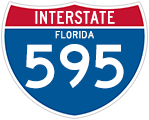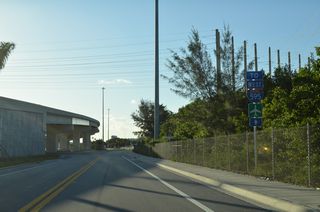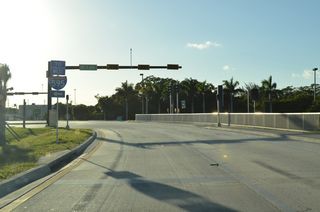
Extending east from the systems interchange joining I-75 with SR 869 (Sawgrass Expressway) to Port Everglades, Interstate 595 is the lone freeway joining coastal areas of Broward County with suburban areas adjacent to the Florida Everglades. Officially named the Port Everglades Expressway, it is popularly known as "595" by locals. Falling within the state road grid for South Florida, SR 862 is the counterpart for I-595.
Interstate 595 parallels SR 84 for its entire length. The one way frontage road system accompanies the Port Everglades Expressway east from I-75 to U.S. 441 adjacent to the exchange with Florida's Turnpike.
A set of managed lanes, the I-595 Express Lanes, run between the east and westbound roadways of Interstate 595 between I-75/SR 869 and I-95 at Fort Lauderdale. Constructed between June 2010 and March 2014, the reversible roadway flows eastbound during weekday mornings and westbound in the evenings. Tolls are charged at variable rates depending upon time of day and traffic congestion.
Interstate 595 Florida Guides
Interstate 595 History
Sometimes called the "Port Expressway", the Port Everglades Expressway was proposed to roughly follow the StateRoad 84 corridor. It would start in western Broward County and extend east to U.S. 1 and SR A1A near Fort Lauderdale-Hollywood International Airport (FLL). The freeway was so named because it would connect Port Everglades in Fort Lauderdale to Naples via SR 84 (Alligator Alley). As envisioned in 1969, the Port Everglades Expressway was planned to be six lanes for the easternmost section (between U.S. 1 and U.S. 441) and four lanes for the remaining sections. Originally, the freeway was planned to be a toll road, and it was planned to be built in one phase between 1969 and 1975 according to the initial proposed funding methods.
The state and Broward County collaborated on the 1969 plan, which envisioned the Port Everglades Expressway as the major freeway link that would act as the main east-west corridor in Broward County. It would also link Port Everglades to Everglades Parkway, which is popularly known as the Alligator Alley, which nominally became part of Interstate 75 in 1977. The route of I-75 changed in 1977 from the U.S. 41 corridor along Tamiami Trail to the Everglades Parkway/Alligator Alley corridor. As a result, the Port Everglades Expressway would now provide a direct connection to the longest Interstate in Florida, Interstate 75. I-75 would then pass within a few miles of Interstate 95 before it would turn south toward Hialeah and Miami. As a result of this modification of Interstate routes in 1977, the Port Everglades Expressway was suddenly seen as a crucial Interstate link, thus offering a direct Interstate connection from Fort Lauderdale to Naples, Fort Myers, and the Gulf Coast.
As news of the new Interstate 75 route sunk in, the Florida Department of Transportation reconfigured its plans for the Port Everglades Expressway. First, it was determined that it would not be a toll road. Instead, the Port Everglades Expressway would be built as an Interstate route, and the state began the process to obtain needed funding to do so. Even though the Port Everglades Expressway would be a spur from I-75 and Alligator Alley, it was numbered as a spur from Interstate 95. Since I-195 and I-395 already existed, the next logical number was Interstate 595. A spur designation from I-75 (such as I-575) was apparently never considered, most likely the original funded segment was the easternmost portion between I-95 and U.S. 1. In fact, the lack of funding for the westernmost section of Interstate 595 almost caused the western third of the Interstate highway to become a toll road after all.
So even with the creation of the Interstate 595 designation, the "lack of funding" issue refused to dissipate. As costs escalated and time marched onward, only a portion of needed Interstate Highway funding was secured by the state in the late 1970s and early 1980s. The remaining funds were not identified. Tolls were again considered, but the Federal Highway Administration guidelines of the time frowned upon tolls as a method of financing Interstate Highways. Specifically the toll portion of the Port Everglades Expressway could not be designated as an Interstate.
However, Congressman Clay Shaw led a group to prevent the Port Everglades Expressway from becoming a toll highway similar to SR 112/Airport Expressway and SR 836/Dolphin Expressway in Miami-Dade County. A former mayor of Fort Lauderdale, Shaw worked with then-Senator (future Governor) Lawton Chiles in 1983 to craft a bill that would allow states to build freeways with money appropriated for repairs. This effort would have freed up to $150 million to construct Interstate 595 and eliminate the proposed tolls, but it failed in the House of Representatives, which deleted that part of the bill in November 1983.
A solution to this issue came in February 1984, when another bill offered to fund Interstate 595 through a loophole that classified the proposed toll section of the Interstate as a "reconstruction" of SR 84, part of which was already designated as I-75. Through this mechanism, Chiles and Shaw enabled Interstate 595 to become fully funded and passed both the Senate and the House; then-President Ronald Reagan signed the bill on March 11, 1984. In addition, the Federal Department of Transportation allocated $21 million to finance the construction of Interstate 595 near Fort Lauderdale-Hollywood International Airport (FLL) on March 2, 1984. With these actions, toll booths were removed from the plans for Interstate 595. Finally, on May 25, 1984, the Senate passed another bill allowing Florida to borrow against anticipated federal highway construction money passed. The bill, sponsored by Senator Jim Scott from Fort Lauderdale, would shave off 18 months of the construction time to construct Interstate 595 by eliminating inflation.
In 1984, plans were finalized for Interstate 595. It was similar to the original plan for the Port Expressway from 1969, but a modified alignment was chosen between I-95 and University Drive, where it would run directly side-by-side with SR 84 and the New River Canal on a slightly more northern track. Under this plan, SR 84 would remain an independent road from Florida's Turnpike east to U.S. 1, where flyover ramps would transform the state road into a frontage road that would follow Interstate 595 west until Davie Road. From Davie Road west to Alligator Alley, SR 84 would become a set of one way frontage roads to the Interstate, with turnarounds at interchanges providing U-turns without motorists having to drive through two signalized intersections.
Interstate 595 was originally built to the following specifications:
- Eight lanes from I-75/SR 869 east to Flamingo Road
- Six lanes from Flamingo Road east to University Drive plus two auxiliary lanes
- Eight lanes from University Drive to Interstate 95
- Six lanes from Interstate 95 east to U.S. 1
There would be an elevated section between I-95 and U.S. 441 as Interstate 595 would traverse the Pond Apple Slough, a wetland preserve. All of its interchanges would be diamonds, except for a four-level stack at Interstate 75 and SR 869 (Sawgrass Expressway), a trumpet at Florida's Turnpike, a four-level partial cloverleaf at U.S. 441, and a four-level stack at Interstate 95. At University Drive, there would be dual flyovers to provide non-stop northbound to westbound and southbound to eastbound connections, in addition to the diamond ramps.
On July 26, 1984, Governor Bob Graham and other state politicians held a gala groundbreaking for the construction of Interstate 595, and construction started later that day for the projected $1.2 billion Interstate. Until 1984, Interstate 595 would be the most expensive road in Florida history. In April 1987, construction started on the massive western interchange with I-75 and SR 869. In May 1988, the first 2 1/3 mile section of Interstate 595 opened, from I-75 east to Hiatus Road. On February 24, 1989, a second 5.3 mile section opened from Florida's Turnpike east to U.S. 1. After five years of construction, on October 21, 1989, the entire section of I-595 (12.8 miles between I-75 and U.S. 1) opened with a ribbon cutting, a six mile parade, and opening day events. Even with the grand opening of the freeway, the major interchanges at I-95, Florida's Turnpike, and I-75/SR 869 were not complete yet, and they would not be finished until 1991. However, the freeway gap between eastern and western Broward County was now closed: Interstate 595 offered a connection across Broward County and to Interstate 75 across the Everglades.
Interstate 595 was officially approved as an Interstate on June 11, 1990, when some of the freeway-to-freeway connections to I-95 were completed.
 scenes scenes |
| Eller Drive parallels the flyover joining Port Everglades to Interstate 595 at the exchange with U.S. 1. The overpass opened to traffic eastbound by December 2, 2014 and westbound by the end of 2014.1 01/23/16 |
| Eller Drive parallels a Florida East Coast (FEC) Railway line west from NE 14th Avenue. An extension of the FEC Railway and a new railroad yard at Port Everglades opened in 2014.1 01/23/16 |
| NE 7th Avenue stems south from Eller Drive to the westbound entrance ramp for Interstate 595. 01/23/16 |
| NE 7th Avenue south at I-595 (Port Everglades Expressway) west. 01/23/16 |
| NE 7th Avenue north at Eller Drive and the Port Everglades Expressway flyover with Interstate 595. 04/01/14 |
Justin Cozart and Jason Learned compiled the original background information for Interstate 595. This information was peviously posted on TropicalTurnpikes.com and was reproduced with permission by Justin Cozart.
- "I-595 overpass opens; traffic to port should ease." Sun Sentinel: Web Edition Articles [TCA] (Fort Lauderdale, FL), December 2, 2014.
Photo Credits:
- 04/01/14 by AARoads and Carter Buchanan. 01/23/16 by AARoads.
Connect with:
Interstate 75
Interstate 95
U.S. 1
U.S. 441
Page Updated 10-15-2020.






